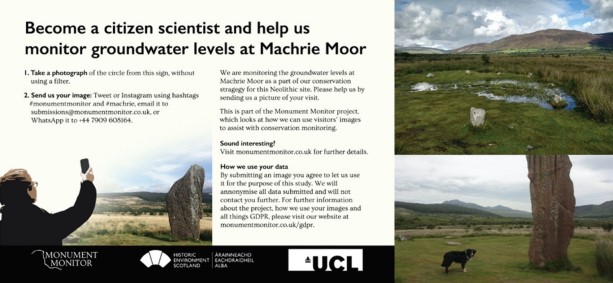Research in collaboration with University College London and Historic Environment Scotland, suggests citizen heritage science as an effective method to gather reliable data for monitoring and documenting heritage sites. For large heritage organisations the monitoring and documentation of sites presents considerable challenges; continual monitoring of smaller, unstaffed, and more remote sites is often not practical.
However, heritage sites are often popular destinations that receive high levels of visitors who carry increasingly sophisticated mobile phones. It seems logical that heritage organisations capitalise on using visitors’ images to record and monitor remote heritage sites. The study compared two methods for data collection: a ‘guided’ approach, in which on-site signage prompts visitor submissions; and an ‘open’ approach, in which the public is asked to send any photographs they have of the site in question.

Signs were placed at each site to prompt visitors to take and submit photographs to the project, using either email, WhatsApp, Twitter, or Instagram. Visitors were prompted to use the hashtag ‘#monumentmonitor’ alongside the name of the site to assist in identification. Individual signs were created for each location, as different aspects were to be monitored at each site. At Machrie visitors were requested to document groundwater flooding, the reoccurrence of which is currently undocumented. At Clava Cairns the site manager was keen to see how visitors experienced the site as well as documented any stone disturbance. As such, visitors were asked to take photos of the cairns ‘from different angles’ to ‘monitor the effects of ground erosion, graffiti and stones being moved’
Both a ‘guided’ and ‘open’ approach to citizen heritage science provided useful data for heritage managers and other stakeholders, as well as engaging visitors with heritage preservation. In addition, the researchers believe there is scope to apply this methodology to research heritage values and community ties to heritage and present this paper as a methodology for heritage institutions to set up similar projects and conduct further research.
Find out more in the open-access publication in the journal Conservation and Management of Archaeoogical Sites: “Using Citizen Heritage Science to Monitor Remote Sites Before and During the First COVID-19 Lockdown: A Comparison of Two Methods”.

How were the two methods of data collection, namely the ‘guided’ approach and the ‘open’ approach, compared in the study?